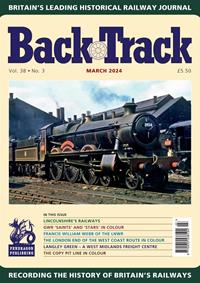|
|
Contents Listing - Articles & Features in this issue
Odd Moments on the Great Eastern Line
First in the Field - Part One
The Locomotive Designs of William Charles Werry (1861-1948)
The Varied History of a Small North Eastern Railway Engine Shed - Northallerton - Part Two
The Impact of the Railway on Alderley Edge in the Nineteenth Century
Crane Laying of Prefabricated Track - Part Four
Glimpses of Mid-Wales Steam in the 1920s and 1930s
The Caprotti Class 5s
Moments of Remembrance
The Railway at Tutbury-Part One
The First Railway Strike
The Building of Ironbridge Power Station
The Swindon Scene
Sent to Work on the Railway
Readers'Forum
Book Reviews
Cover - SR N15X 'Remembrance' 4-6-0 No.32331 Beattie at Windsor & Eton Riverside after working the 'Riverside Special' from London Bridge on 23rd June 1957.
Article Snippets
The colour of the railway:
Guest editorial time again - and this month contributor ALISTAIR F. NISBET has some views on how railway companies and train operators present themselves to the public. A spell of enforced inactivity after a few days as an 'in-patient' gave me more time than usual to think deep (?) thoughts and one occasion found me musing on the colours into which railway companies paint their trains and, to a lesser extent, their infrastructure. All through the history of our railway system different companies have applied varying coats of many colours to almost anything which moved although less often to those objects which stayed static - nevertheless London Underground has in recent years applied a particularly light shade of blue to some of its girder bridges on the Metropolitan Line. Quite unlike anything on the traditional railway...
In these days of frequently changing franchisees it seems that as soon as a new operator is appointed at least one of its train sets appears in a new, and often quite garish, colour scheme on the first day of operation. Even when the incumbent retains a franchise a new colour scheme seems to be called for. Do the passengers really notice the difference and think 'new colours mean a new train'? Except perhaps in the case of Virgin Trains most are fairly unmemorable or at best easily forgotten. I wonder, though, whether it was ever very different. Apart from we railway enthusiasts, who can truly say they remember what colour the LNER painted its engines post-World War II? Or the Southern Railway with its olive green or Bulleid's malachite version? Or even further back some of the pre-grouping colour schemes such as the Great Eastern's. The Great Western, of course, did not need to change anything at the grouping nor even after nationalisation - apart from the letters and crest becoming the 'cycling lion'. A lack of cleaners in later BR days, of course, produced many instances of the famous grey tinged with oil and grease.
What about the naming of engines? Much has been written elsewhere, and occasionally in Backtrack, about the policies of the major companies and the themes they adopted - the Great Western was well known for its tradition of names of, sometimes rather obscure, buildings with the main exceptions being past male English monarchs and administrative areas. The London, Brighton & South Coast applied names to most of its engines at one time, these being painted in large capitals on the side tanks or driving wheel splashers, but it was often said to be a cause of confusion for travellers, especially those who were not frequent users of the company's services. Why was this, you might ask? - because the names chosen were often those of towns and villages, or occasionally stately homes, served by the Brighton - not the destination of the train the locomotive was attached to. Thinking back over the many newspaper reports I have read about the opening of new stretches of railway or of unfortunate incidents,
I am struck that in almost none of them has there been a mention of the colour of the rolling stock nor of the engine for that matter. I think, however, that some description of this sort was reported on the advent of the 'Coronation Scot' on the LMS and Sir Nigel Gresley's streamliners on the LNER. Every time a new colour scheme is decided upon it must involve a considerable expense whether the change is implemented by repainting or, in more recent times, by wrapping the vehicle in vinyl. But what was the traditional colour for railway infrastructure? During the 1950s and '60s BR's Regions seem to have had a penchant for applying different colour schemes to some of their station buildings and in some cases these coincided with the colour of the sausageshaped nameboards which graced the premises. I doubt, though, that the erstwhile North Eastern Region ever used tangerine on any stations or other buildings.
Could I have seen chocolate and cream on the wooden buildings at Royal Oak just outside Paddington or a peeling version of maroon and cream at Willesden Junction? Maybe 'A Reader' can say yea or nay. One scheme I do recall was to be found on a number of Scottish Region stations where a large area of woodwork might be painted a light cream above waist level and chocolate brown below there and on door frames. Who knows how that came about? The Southern Region also liked cream but in this case a deeper shade allied with a darkish green for window and frames and doors. This too looked very attractive when new although when applied straight on top of the dirt it was supposed to hide, such as I once saw at Wimbledon station in the early 1960s, it was less so. So my closing thought is did/do the companies old and new need to distinguish themselves with so many different liveries? Perhaps it was easier and simpler when engines were painted black with the owning company's crest/logo/symbol applied on top. But then how dull it would be, especially for those of us who photograph railways in all their aspects. Should we all go backto monochrome only? Perhaps there is no real answer or, perish the thought, there is no real problem?
Alistair F. Nisbet
Guest editorial time again - and this month contributor ALISTAIR F. NISBET has some views on how railway companies and train operators present themselves to the public. A spell of enforced inactivity after a few days as an 'in-patient' gave me more time than usual to think deep (?) thoughts and one occasion found me musing on the colours into which railway companies paint their trains and, to a lesser extent, their infrastructure. All through the history of our railway system different companies have applied varying coats of many colours to almost anything which moved although less often to those objects which stayed static - nevertheless London Underground has in recent years applied a particularly light shade of blue to some of its girder bridges on the Metropolitan Line. Quite unlike anything on the traditional railway...
In these days of frequently changing franchisees it seems that as soon as a new operator is appointed at least one of its train sets appears in a new, and often quite garish, colour scheme on the first day of operation. Even when the incumbent retains a franchise a new colour scheme seems to be called for. Do the passengers really notice the difference and think 'new colours mean a new train'? Except perhaps in the case of Virgin Trains most are fairly unmemorable or at best easily forgotten. I wonder, though, whether it was ever very different. Apart from we railway enthusiasts, who can truly say they remember what colour the LNER painted its engines post-World War II? Or the Southern Railway with its olive green or Bulleid's malachite version? Or even further back some of the pre-grouping colour schemes such as the Great Eastern's. The Great Western, of course, did not need to change anything at the grouping nor even after nationalisation - apart from the letters and crest becoming the 'cycling lion'. A lack of cleaners in later BR days, of course, produced many instances of the famous grey tinged with oil and grease.
What about the naming of engines? Much has been written elsewhere, and occasionally in Backtrack, about the policies of the major companies and the themes they adopted - the Great Western was well known for its tradition of names of, sometimes rather obscure, buildings with the main exceptions being past male English monarchs and administrative areas. The London, Brighton & South Coast applied names to most of its engines at one time, these being painted in large capitals on the side tanks or driving wheel splashers, but it was often said to be a cause of confusion for travellers, especially those who were not frequent users of the company's services. Why was this, you might ask? - because the names chosen were often those of towns and villages, or occasionally stately homes, served by the Brighton - not the destination of the train the locomotive was attached to. Thinking back over the many newspaper reports I have read about the opening of new stretches of railway or of unfortunate incidents,
I am struck that in almost none of them has there been a mention of the colour of the rolling stock nor of the engine for that matter. I think, however, that some description of this sort was reported on the advent of the 'Coronation Scot' on the LMS and Sir Nigel Gresley's streamliners on the LNER. Every time a new colour scheme is decided upon it must involve a considerable expense whether the change is implemented by repainting or, in more recent times, by wrapping the vehicle in vinyl. But what was the traditional colour for railway infrastructure? During the 1950s and '60s BR's Regions seem to have had a penchant for applying different colour schemes to some of their station buildings and in some cases these coincided with the colour of the sausageshaped nameboards which graced the premises. I doubt, though, that the erstwhile North Eastern Region ever used tangerine on any stations or other buildings.
Could I have seen chocolate and cream on the wooden buildings at Royal Oak just outside Paddington or a peeling version of maroon and cream at Willesden Junction? Maybe 'A Reader' can say yea or nay. One scheme I do recall was to be found on a number of Scottish Region stations where a large area of woodwork might be painted a light cream above waist level and chocolate brown below there and on door frames. Who knows how that came about? The Southern Region also liked cream but in this case a deeper shade allied with a darkish green for window and frames and doors. This too looked very attractive when new although when applied straight on top of the dirt it was supposed to hide, such as I once saw at Wimbledon station in the early 1960s, it was less so. So my closing thought is did/do the companies old and new need to distinguish themselves with so many different liveries? Perhaps it was easier and simpler when engines were painted black with the owning company's crest/logo/symbol applied on top. But then how dull it would be, especially for those of us who photograph railways in all their aspects. Should we all go backto monochrome only? Perhaps there is no real answer or, perish the thought, there is no real problem?
Alistair F. Nisbet
Adverts and Links based on this content
Advertisement




